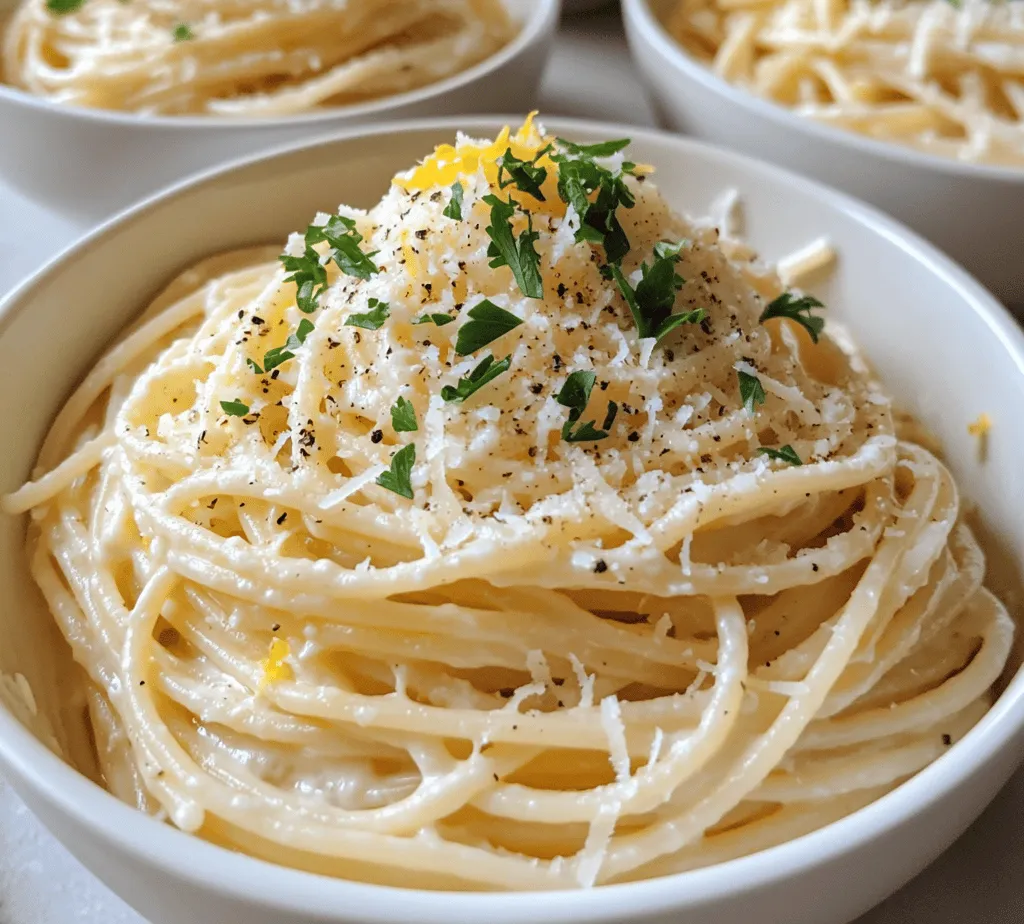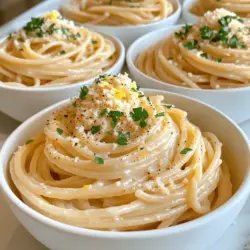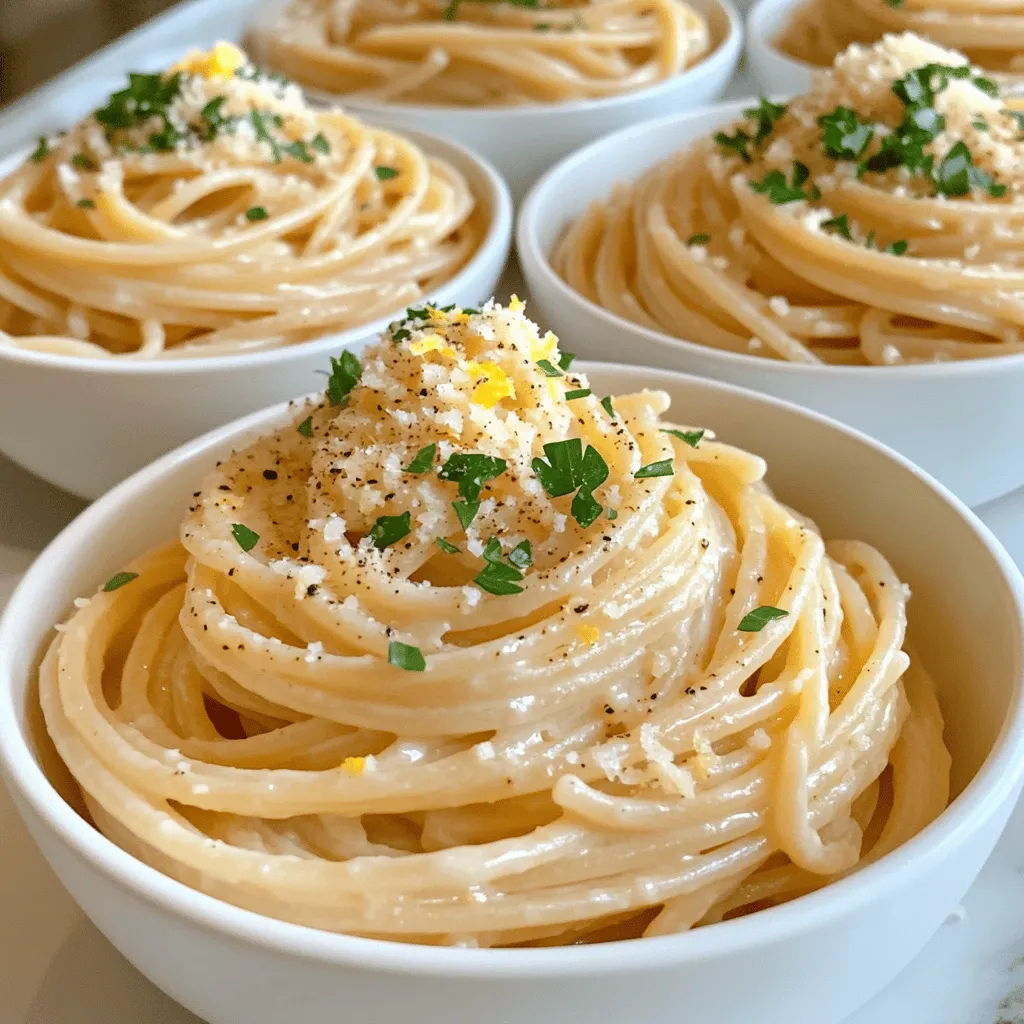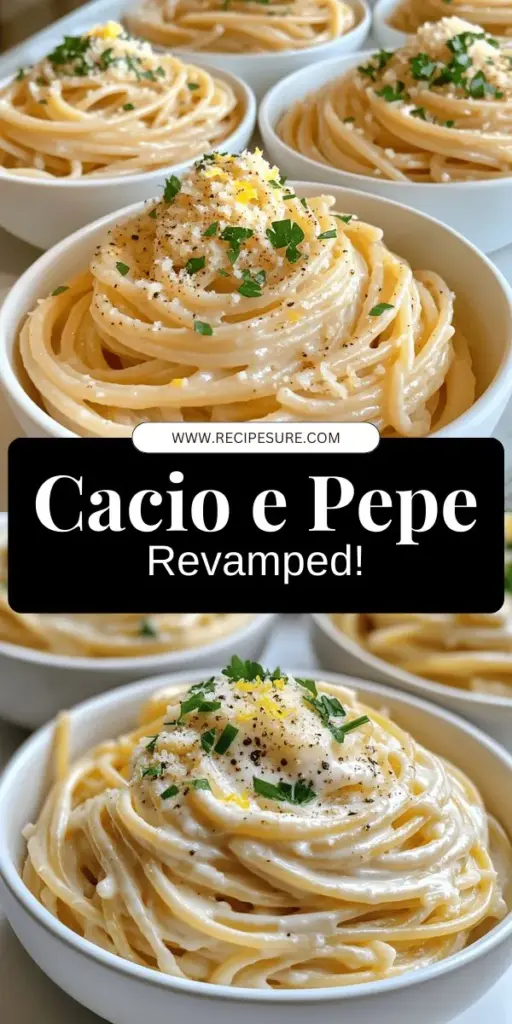Introduction
Cacio e Pepe is not just a dish; it is a culinary experience that embodies the essence of Roman cuisine. Known for its simplicity and depth of flavor, this traditional Italian pasta dish consists of just three core ingredients: pasta, Pecorino Romano cheese, and freshly cracked black pepper. Over the years, Cacio e Pepe has garnered a loyal following, transcending borders and becoming a beloved staple in many kitchens around the world.
However, while the classic recipe remains a favorite, there is always room for innovation in the kitchen. In this article, we are excited to introduce a delightful twist to the traditional Cacio e Pepe by incorporating a hint of lemon zest and a drizzle of high-quality olive oil. This refreshing addition not only elevates the dish’s overall flavor profile but also adds brightness that complements the rich, salty notes of the Pecorino Romano cheese.
Join us as we delve into the origins of this iconic dish, explore the key ingredients that contribute to its signature taste, and provide a step-by-step guide to making Cacio e Pepe with a Twist. Whether you’re a seasoned cook or a culinary novice, this recipe promises to impress your family and friends at your next dinner gathering.
Understanding the Origins of Cacio e Pepe
To truly appreciate Cacio e Pepe, it is essential to understand its roots and significance in Italian culture. Originating from Rome, this dish is a testament to the Italian philosophy of “less is more.” Traditionally, the recipe was crafted by shepherds who needed a quick, hearty meal while tending to their flocks in the countryside. The simplicity of the dish made it convenient for preparation using minimal resources, relying heavily on staple ingredients that were readily available.
At the heart of Cacio e Pepe is Pecorino Romano cheese, a hard, salty cheese made from sheep’s milk. This cheese is a cornerstone of Roman cuisine, celebrated for its robust flavor that enhances a variety of dishes. The cheese’s unique characteristics lend themselves beautifully to the creamy sauce formed when combined with starchy pasta water, resulting in a velvety texture that clings to each strand of pasta.
The historical context of simple pasta dishes in Italy highlights the cultural significance of Cacio e Pepe. Italian cuisine has long embraced the idea of using high-quality ingredients to create uncomplicated yet flavorful meals. The dish exemplifies this philosophy, showcasing how a few carefully selected components can come together to create something truly extraordinary.
Key Ingredients and Their Importance
As we prepare to elevate our Cacio e Pepe experience with a twist, it is crucial to understand the key ingredients that play a vital role in achieving the perfect dish.
Pasta Selection: Spaghetti vs. Tonnarelli
The choice of pasta can significantly impact the final outcome of Cacio e Pepe. Traditionally, spaghetti is the pasta of choice due to its long, thin shape that allows for even distribution of the cheese and pepper sauce. However, Tonnarelli, a thicker, square-shaped pasta from the Lazio region, is becoming increasingly popular among pasta enthusiasts. Its texture provides an excellent surface for sauce adherence, enhancing the overall flavor experience. When choosing your pasta, consider your personal preference, but both options will yield delicious results.
The Role of Pecorino Romano Cheese
Pecorino Romano cheese is undoubtedly the star ingredient in Cacio e Pepe. This cheese contributes a sharp, tangy flavor that is essential for achieving the dish’s authentic taste. It is important to use high-quality, freshly grated Pecorino Romano to ensure optimal flavor and texture. Pre-grated cheese often contains anti-caking agents that can hinder the creamy sauce’s formation, so grating your cheese fresh is highly recommended.
Understanding the Impact of Fresh Cracked Black Pepper
Freshly cracked black pepper is another essential component of Cacio e Pepe that adds depth and warmth to the dish. The heat from the pepper balances the richness of the cheese, creating a harmonious flavor profile. For the best results, use a pepper mill to crack whole peppercorns just before cooking. This ensures maximum flavor and aroma, which dried, pre-ground pepper simply cannot replicate.
The Addition of Olive Oil: Enhancing Creaminess and Flavor
In our twist on Cacio e Pepe, we introduce the addition of high-quality extra virgin olive oil. This ingredient not only enhances the creamy texture of the sauce but also adds a layer of complexity to the flavor profile. The rich, fruity notes of the olive oil complement the sharpness of the Pecorino Romano and the heat of the black pepper, creating a well-rounded dish that is anything but ordinary.
The Brightening Effect of Lemon Zest
Adding lemon zest to our Cacio e Pepe with a Twist brings a refreshing brightness that elevates the dish to new heights. The zesty aroma and flavor contrast beautifully with the richness of the cheese and the warmth of the pepper. When using lemon zest, be sure to use a microplane grater to obtain fine shavings that will easily infuse the dish without overwhelming it.
Optional Garnishes: Fresh Parsley for Color and Taste
While Cacio e Pepe is typically served simply, adding a garnish of fresh parsley can enhance both the presentation and the flavor. The bright green color of the parsley provides a beautiful contrast to the creamy pasta, while its mild, herbaceous taste adds an extra layer of freshness. Simply chop some fresh parsley and sprinkle it over the finished dish for a pop of color and flavor.
Step-by-Step Guide to Making Cacio e Pepe with a Twist
Now that we have explored the origins and key ingredients of Cacio e Pepe with a Twist, it is time to dive into the cooking process. Follow these detailed steps to ensure your dish turns out perfectly every time.
Preparing the Pasta: Cooking Techniques for Perfect Al Dente
1. Choose the Right Pot: Begin by selecting a large pot to cook your pasta. This allows the spaghetti or tonnarelli to move freely in the boiling water, preventing it from becoming sticky.
2. Bring Water to a Boil: Fill the pot with water and add a generous amount of salt (about 1-2 tablespoons). Bring the water to a rolling boil. The salt is crucial for flavoring the pasta, so don’t skip this step.
3. Cook the Pasta: Once the water is boiling, add the pasta and cook according to the package instructions until it reaches al dente doneness. This typically takes about 8-10 minutes, depending on the type of pasta used. Be sure to stir occasionally to prevent sticking.
4. Reserve Pasta Water: Before draining the pasta, reserve about 1-2 cups of the starchy cooking water. This water will be essential for creating the sauce.
5. Drain the Pasta: After the pasta is cooked, drain it in a colander, shaking off any excess water. Do not rinse the pasta, as this will wash away the starch needed for the sauce.
Creating the Cheese and Pepper Mixture: Tips for Achieving the Right Consistency
1. Combine Cheese and Pepper: In a mixing bowl, combine the freshly grated Pecorino Romano cheese and a generous amount of freshly cracked black pepper (about 1-2 teaspoons, to taste). Mix well to ensure the pepper is evenly distributed throughout the cheese.
2. Create the Sauce: In a large skillet or sauté pan, heat a drizzle of extra virgin olive oil over medium heat. Add a ladle of the reserved pasta water to the skillet, followed by the cheese and pepper mixture. Stir continuously to create a creamy sauce.
3. Add the Pasta: Once the sauce is well combined, add the drained pasta to the skillet. Toss the pasta with the sauce, adding more reserved pasta water as needed to achieve the desired creaminess.
4. Incorporate Lemon Zest: Just before serving, add the freshly grated lemon zest to the pasta, tossing it to combine. This step infuses the dish with a refreshing brightness that elevates the overall flavor profile.
By following these steps, you’ll be well on your way to creating an elevated version of Cacio e Pepe that is sure to impress. The combination of traditional flavors with a modern twist will make your dish stand out while maintaining the classic charm that has made Cacio e Pepe a timeless favorite.
Stay tuned for the next part of this article, where we will provide additional tips for achieving the best results and address common questions about preparing this delightful dish.

The Art of Mixing: Combining Pasta with the Sauce Seamlessly
Achieving the perfect blend of pasta and sauce is essential for Cacio e Pepe with a Twist. After cooking your pasta until al dente, it’s time to unite it with your beautifully crafted sauce. The secret lies in timing and technique. Start by transferring the drained pasta directly into the skillet containing your melted butter, olive oil, and cheese mixture. Avoid rinsing the pasta, as this removes the starch that helps bind the sauce.
As soon as you add the pasta, immediately begin tossing it with tongs. The goal is to coat every strand evenly without breaking the delicate noodles. If the cheese seems clumpy, don’t fret; this is where the reserved pasta water comes into play. Gradually add small amounts of the starchy water while tossing. This technique not only helps melt the cheese into a creamy sauce but also creates a luscious consistency that clings beautifully to the pasta.
Incorporating Lemon Zest: Timing and Techniques for Infusion
One of the standout features of this Cacio e Pepe recipe is the bright, zesty kick from the lemon. To incorporate lemon zest effectively, it’s crucial to add it at the right moment. Once your pasta is well-coated and the sauce is creamy, remove the skillet from the heat. Sprinkle the zest of one lemon over the pasta, then toss again to distribute the citrus aroma throughout the dish.
This timing is essential because adding lemon zest while the skillet is still on high heat can cause it to lose its fresh flavor. The residual heat from the pasta will gently infuse the zest into the sauce, elevating the dish without overwhelming the traditional peppery flavor that Cacio e Pepe is known for.
Final Touches: Salt Adjustment and Garnishing for Presentation
Once you’ve combined the pasta and sauce, it’s crucial to taste for seasoning. The cheese and pasta water already contribute some saltiness, so be mindful when adjusting with additional salt. A pinch or two may be necessary to enhance the flavors, but it’s best to err on the side of caution, as you can always add more if needed.
For garnishing, the presentation is key when serving Cacio e Pepe with a Twist. Use a microplane to grate fresh Pecorino Romano over the top. This not only adds an appealing visual element but also a burst of flavor. A sprinkle of freshly cracked black pepper and a few chopped parsley leaves bring color and enhance the dish’s aroma. Consider serving it in shallow bowls to highlight the pasta’s creamy texture and make it more inviting.
Cooking Techniques for Perfecting Your Dish
The Importance of Reserving Pasta Water and Its Role in Sauce Consistency
One of the most crucial techniques in making a creamy sauce is reserving pasta water. The starchy water acts as a natural thickening agent, helping to achieve the desired consistency in your sauce. Before draining your pasta, set aside one to two cups of the cooking water. This starchy liquid should be added a little at a time as you combine the pasta with the sauce, allowing you to control the thickness.
If you find your sauce too thick, a splash of reserved pasta water can help loosen it without diluting the flavor. Conversely, if the sauce is too thin, letting it cook a bit longer in the skillet will help it thicken up.
Understanding the Heat: Managing Skillet Temperature for Creamy Sauce
Managing your skillet’s heat is essential for a successful Cacio e Pepe. After cooking your pasta, lower the heat to medium or medium-low when combining it with the sauce. High heat can cause the cheese to clump rather than melt smoothly. If you notice that the sauce is becoming too thick, adjust the heat accordingly and add reserved pasta water to maintain that creamy texture.
Tips for Tossing Pasta: Ensuring Even Coating Without Breaking Strands
Tossing pasta properly is an art that ensures even distribution of sauce without damaging the noodles. Use tongs or a pasta fork to lift and turn the pasta gently. Start from the bottom of the skillet and work your way to the top, allowing the sauce to envelop each strand. If you’re having trouble with the pasta sticking, add a bit more reserved water to help it glide smoothly. This method guarantees that every bite is as flavorful as the last.
Serving Suggestions and Presentation Ideas
Creative Plating Techniques for an Appealing Visual Presentation
When it comes to serving Cacio e Pepe with a Twist, presentation can enhance the dining experience. Consider these plating techniques to impress your guests:
1. Twirl Technique: Use a fork to twirl a portion of pasta into a neat nest in the center of the plate. This creates an inviting focal point.
2. Layering: For a more rustic look, layer pasta and sauce in a shallow bowl, allowing the creamy sauce to pool beautifully at the bottom.
3. Side Dishes: Serve with a simple arugula salad drizzled with lemon vinaigrette to balance the richness of the dish.
Garnishing with Black Pepper and Parsley: Enhancing Both Flavor and Aesthetics
For that finishing touch, garnishing is essential. Freshly cracked black pepper adds a punch of spice, while a sprinkle of vibrant parsley enhances the dish’s visual appeal. Consider using microgreens or edible flowers for a gourmet touch that elevates the overall presentation.
Using Additional Pecorino Romano for an Extra Touch of Indulgence
An additional layer of freshly grated Pecorino Romano can take your Cacio e Pepe to the next level. Not only does it enhance the flavor, but it also creates a visually stunning layer of cheese that melts just slightly into the warm pasta. Always use high-quality cheese for the best results.
Nutritional Benefits of Cacio e Pepe
Analyzing the Nutritional Profile of the Key Ingredients
Cacio e Pepe is not only delicious but also offers a balanced nutritional profile, thanks to its simple, wholesome ingredients:
- Pasta: Provides carbohydrates, essential for energy. Whole-grain varieties can boost fiber content.
- Pecorino Romano: A rich source of protein and calcium, contributing to bone health.
- Black Pepper: Contains piperine, which has antioxidant properties and may aid in digestion.
Exploring the Balance of Carbohydrates, Fats, and Proteins
This dish strikes a delightful balance between carbohydrates, fats, and proteins. The pasta serves as a primary carbohydrate source, while the cheese adds healthy fats and proteins. The olive oil contributes heart-healthy monounsaturated fats, making this dish satisfying without being overly heavy.
Potential Variations for Dietary Preferences
For those looking to modify the recipe for dietary preferences, several variations can be considered:
- Gluten-Free Pasta: Substitute traditional pasta with gluten-free options, such as brown rice or chickpea pasta, to accommodate gluten sensitivities.
- Vegan Cheese Options: Use nutritional yeast or cashew-based cheeses for a dairy-free alternative while still achieving a cheesy flavor.
- Whole Grain Pasta: Opt for whole grain pasta to increase fiber intake and enhance the nutritional benefits.
Conclusion
Cacio e Pepe with a Twist offers a delightful blend of tradition and innovation, perfect for pasta lovers seeking to elevate their dining experience. By carefully selecting ingredients and following the preparation steps


